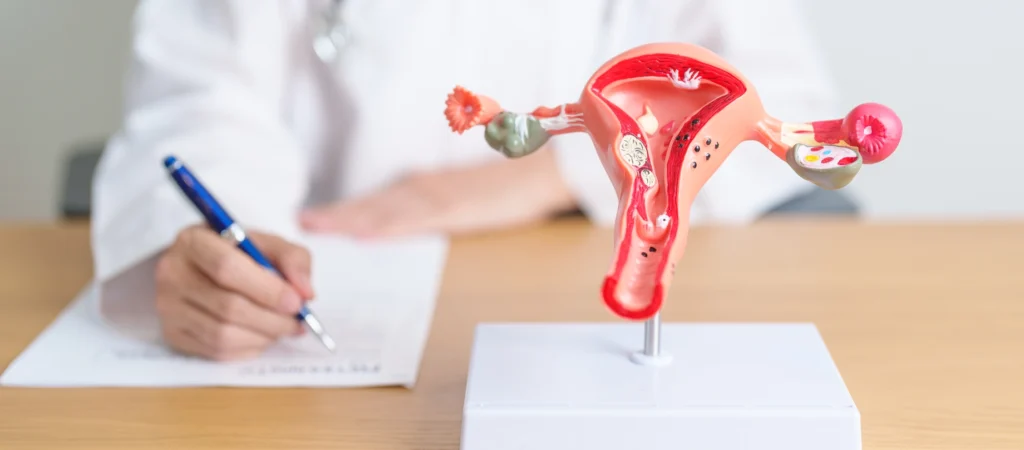hOW TO dIAGNOSE pCOD/PCOS?
dR. jYOTI sINGH REDDY

The journey through PCOS (Polycystic Ovary Syndrome)/ PCOD (Polycystic Ovarian Disease), can be bewildering, especially for teenagers navigating hormonal changes. As a gynecologist, I empathize with the uncertainties young women face regarding their health, particularly concerns surrounding PCOS. I treat numerous women and girls for PCOS every year and more public knowledge about the disease has not helped in removing truth from the myths. Let’s understand the disease and everything it entails.
Book an Appointment with our Gynaecologist if you feel like you have any concerning issue!
PCOS/PCOD in Teens
The teenage years are a pivotal period where girls begin to understand their bodies, and often mistake the signs for PCOS. However, understanding the signs needs patience and a deeper understanding of the body’s hormonal maturation. We can’t rush into self-diagnosis!
At ages 13 or 14, many teenagers may experience symptoms seemingly indicative of PCOS, like irregular periods, acne, Hirsutism (male-pattern hair growth on a woman’s face, chest and back, or weight management issues.
But did you know the hormonal axis in females matures gradually. Waiting until around 18 allows for a more accurate assessment by a gynecologist. Rushing to conclusions prematurely can lead to unnecessary anxiety and potential misdiagnosis. Don’t self-diagnose!
The Hormonal Axis of women
Let’s understand the hormonal Axis of women. It is an intricate network that orchestrates various bodily functions, including menstrual cycles, fertility, and overall hormonal balance. During adolescence, this axis undergoes a significant transformation, but it is a gradual process that spans several years.
At around 13 or 14 years old, many young women may notice changes in their bodies, such as irregular periods or acne, which may spark concerns about conditions like PCOS. However, the interplay between hormones like estrogen, progesterone, testosterone, LH, and FSH takes time to establish a delicate balance.
This maturation process extends into late adolescence and early adulthood, typically reaching a more stabilized state around the age of 18. Rushing to diagnose conditions like PCOS before this maturity stage can lead to misinterpretation of symptoms, as the body is still in the process of finding its hormonal equilibrium. Thus, allowing this natural progression to occur and seeking professional evaluation at the appropriate stage plays a crucial role in accurate diagnoses and effective management of hormonal conditions.

The Three-Step Diagnosis
PCOS presents a spectrum of symptoms that require careful evaluation for accurate diagnosis. It is easy to see one Conforming symptom and assume we have PCOS/PCOD. Let’s explore three-pronged diagnostic approach serves as a comprehensive roadmap, encompassing an assessment of visible signs, diving deep into hormonal imbalances, and scrutinizing ovarian health through ultrasound examinations.
Symptom Analysis: Unveiling Clues
The initial phase of diagnosis involves understanding and recognizing potential symptoms that might suggest PCOS. Irregular menstrual cycles, Acne, excess hair growth, or challenges in weight management serve as crucial indicators for further investigation and intervention.
Hormonal Parameters: Deciphering the Imbalances
Once potential symptoms are identified, a deeper exploration of hormonal imbalances becomes crucial. Blood tests that examine hormone levels such as testosterone, estrogen, luteinizing hormone (LH), and follicle-stimulating hormone (FSH) offer valuable insights. Elevated levels of testosterone, often seen in PCOS, disrupt the delicate hormonal balance and contribute to various symptoms. Additionally, an imbalance in LH and FSH levels can affect ovulation and the regularity of menstrual cycles. Analyzing these hormonal parameters aids in understanding the underlying hormonal irregularities associated with PCOS, contributing to a more accurate diagnosis.
Ultrasound Examination: Revealing Ovarian Insights
Complementing the symptom analysis and hormonal assessments, an ultrasound examination of the ovaries provides a direct view of their structure and condition. PCOS patients more often than not, have enlarged ovaries with small, fluid-filled sacs which are called follicles.
The follicles may cluster around the outer edge of the ovaries, forming the characteristic appearance often associated with PCOS. This ultrasound assessment helps confirm the presence of cysts or other irregularities, further solidifying the diagnosis.
The Final Word
While each step independently offers valuable insights, it’s the integration of findings from symptom analysis, hormonal parameters, and ultrasound examination that forms the cornerstone of a PCOS diagnosis. A confirmed diagnosis typically requires the presence of at least two of the following: irregular menstrual cycles, elevated androgen levels (like testosterone), and ovarian cysts observed via ultrasound.
The Final
